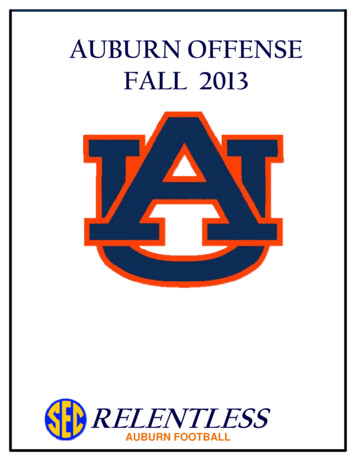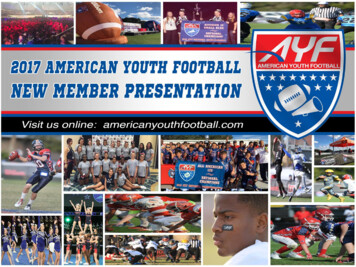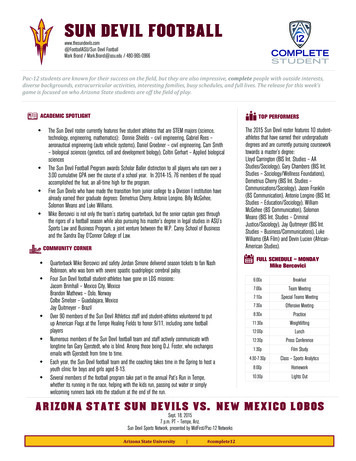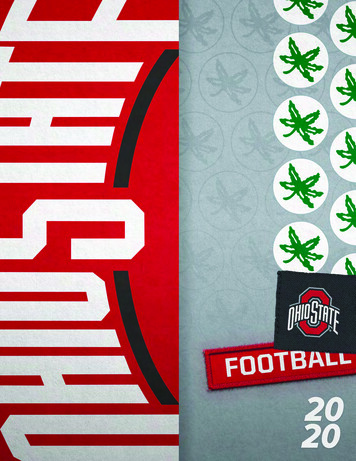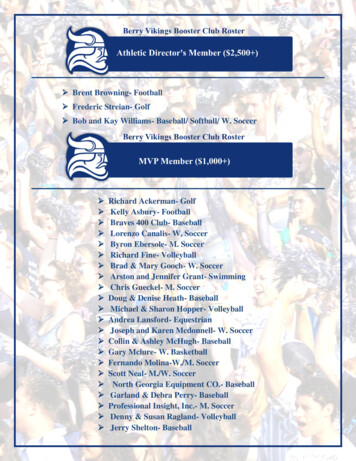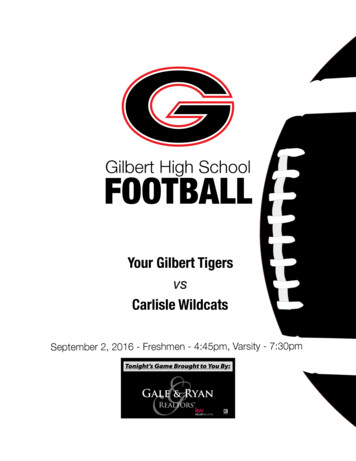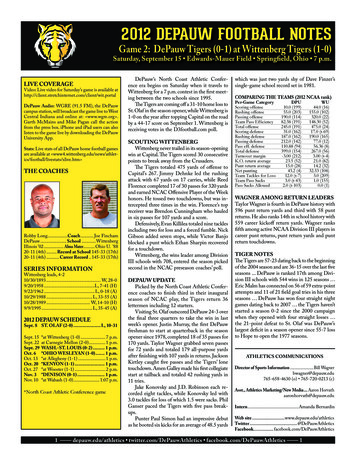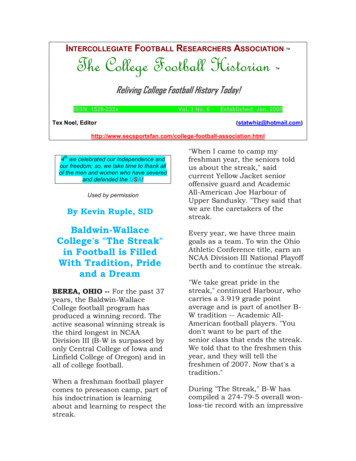
Transcription
INTERCOLLEGIATE FOOTBALL RESEARCHERS ASSOCIATION The College Football Historian Reliving College Football History Today!ISSN: 1526-233xTex Noel, EditorVol. 2 No. 6Established: Jan. com/college-football-association.htmlth4 we celebrated our Independence andour freedom; so, we take time to thank allof the men and women who have severedand defended the USA!Used by permissionBy Kevin Ruple, SID"When I came to camp myfreshman year, the seniors toldus about the streak," saidcurrent Yellow Jacket senioroffensive guard and AcademicAll-American Joe Harbour ofUpper Sandusky. "They said thatwe are the caretakers of thestreak.Baldwin-WallaceCollege's "The Streak"in Football is FilledWith Tradition, Prideand a DreamEvery year, we have three maingoals as a team. To win the OhioAthletic Conference title, earn anNCAA Division III National Playoffberth and to continue the streak.BEREA, OHIO -- For the past 37years, the Baldwin-WallaceCollege football program hasproduced a winning record. Theactive seasonal winning streak isthe third longest in NCAADivision III (B-W is surpassed byonly Central College of Iowa andLinfield College of Oregon) and inall of college football."We take great pride in thestreak," continued Harbour, whocarries a 3.919 grade pointaverage and is part of another BW tradition -- Academic AllAmerican football players. "Youdon't want to be part of thesenior class that ends the streak.We told that to the freshmen thisyear, and they will tell thefreshmen of 2007. Now that's atradition."When a freshman football playercomes to preseason camp, part ofhis indoctrination is learningabout and learning to respect thestreak.During "The Streak," B-W hascompiled a 274-79-5 overall wonloss-tie record with an impressive
The College Football Historian-2.779 winning percentage. TheYellow Jackets have made 10Ohio Athletic Conference titles,made five trips to the Division IIINational Playoffs and won theDivision III National title in 1978when they defeated then OhioAthletic Conference foeWittenberg University, 24-10, inPhenix City Alabama. B-W's bestseason during "The Streak" wasits national championship year of1978 when the Yellow Jacketswere 11-0-1 overall. B-W had twoother undefeated regular seasonrecords, in 1982 and 1991.Eleven times during "The Streak"B-W has lost just once, includingthis year.Three head coaches have led B-Wduring "The Streak". The late andlegendary Lee Tressel mentoredB-W from the beginning of "TheStreak" in 1967 until hisretirement in 1980. Tressel had acareer 155-52-6 mark and .742winning percentage. Recentlyretired Head Coach Bob Packardproduced a career record of 15654-2 and a .741 winningpercentage from 1981 through2002. During the past two yearsand heading into this year'sNCAA Division III Playoffs,current Yellow Jacket leader,John Snell, has an 18-3 recordand an outstanding .833 winningpercentage."We talk about "The Streak" withour kids but we don't belabor thepoint," said Snell, a 1987graduate of the College. "It is apart of Yellow Jacket football."What is so impressive about thestreak is that involves so manygreat young men who have cometo B-W, gotten a great educationand have had a chance to play ina football program that has anoutstanding tradition ofexcellence in so many areas,"said Packard. "Winning iscertainly a part of success andachievement."I think that the lessons youngmen learn in football makes a bigdifference later in life and inwhatever they go on to do for acareer," continued Packard."Learning how to win gracefullyand how to handle defeat wellteaches you a great lesson. Ithink our winning streak andtradition of winning has made adifference in the lives of manyyoung men."Ohio State Head Coach JimTressel is just one of thosepeople," said Packard, who wasTressel's position coach from1971-74. "We have had footballplayers go on to successfulcareers in medicine, business,education and many othervocations, and every one of themwill tell you that the lessons thatthey learned on the field playedan important role in theirsuccess today. And, every one ofthem will tell you that they stilltake great pride today in "TheStreak"."
The College Football Historian-3Twice during "The Streak," B-Whad to win its final four games ofthe year to preserve the feat,including 1995 when the YellowJackets upset Cleveland crosstown rival John CarrollUniversity, 31-3."The Streak" is a motivatingfactor at times," said Packard. "In1995, we began the year at 2-4and had to find a way ofmotivating the players. We hadalready put ourselves in aposition where we couldn't winan OAC title and we knew weweren't going to make theplayoffs. It was a matter of pride.It was great to see our kids riseto the occasion and play each ofthose last four games like it wasfor the OAC title and an NCAAPlayoff berth."In 1989, the streak was again injeopardy. The Yellow Jacketsbegan the season with a 1-4-1record with two of the defeatscoming at the hands of DivisionII teams Ashland and St.Joseph's (Ind.). Again, the backswere to the wall.But as pride and tradition gainsmomentum, so did B-W. A 28-7win against Ohio Northern wasfollowed by victories againstCapital (38-0) and Marietta (277). All of a sudden, the YellowJackets again had a 4-4-1record. It left the season-endingshowdown with JCU as the gameto either continue or end "TheStreak". On a cold, rainy andsnowy day in University Heights,B-W spoiled Parents' Day for theBlue Streaks and blew out JCU,31-3. Following its halftimeceremony, the JCU faithfuldeparted and left just the B-Wfans to celebrate its win andcontinuation of "The Streak.""That was one of the best seasonending banquets that I attendedin my 41 years at B-W as aplayer, assistant coach and headcoach," said Packard. "We hadovercome so much adversity toaccomplish a goal as a team.That is what you get intocoaching to see. It was ahighlight that I will never forget.Every kid at that banquet washappy."Another season that "The Streak"was in jeopardy was in the Fall of1983. B-W opened the seasonwith four straight losses. Theyear previous, B-W had a 10-0regular season and had advancedto the Division III Playoffs beforelosing a close game to eventualnational champion Augustana(Ill.), 28-22. To begin the seasonat 0-4 was almost unthinkable.One of the other three losses alsocame at home to perennial OACand national power, and worseyet, traditional arch-rivalWittenberg University, 12-10."We had played some good teamsto open the season and lost someclose games," rememberedPackard. "We lost the opener to avery good Ashland team and thenthe next three by a total of sixpoints. We had a very good team
The College Football Historian-4that year and they were almost ina state of shock. But, we knewthat we could come back."In the great tradition that is B-Wfootball, it did come back, andwith a vengeance that produced achampionship.In the early 1980s, the OhioAthletic Conference was a 14team league that was split intotwo divisions, the red and theblue. In divisional play, eachteam played five games. Thedivisional winners met in the10th game of the season to playfor the OAC ChampionshipGame.With its 0-4 overall record in1983, B-W began divisional play.The Yellow Jackets beat a goodMuskingum team, 22-14, in NewConcord. The Muskies celebratedHomecoming that day. They hada veteran team returning and feltthat it was their season to win adivisional title. On the very firstplay of the game, B-W's 5'6"defensive tackle Bryan Borowymade maybe the most importantplay of the season. He picked offa Muskie screen pass and ran itback for a touchdown. That playignited B-W for the rest of theyear.In its next four divisional games,the Yellow Jackets disposed ofMount Union (28-19), Capital(23-0), Heidelberg (32-14) andWooster (35-16). It set up aNovember showdown inSpringfield with Wittenberg forthe OAC title. With 3,973 inattendance, B-W and Wittenbergtraded touchdowns. B-W scoredin the first quarter, Wittenberg inthe second, the Yellow Jackets inthe third and the Tigers tied thegame at 14-14 with a TD with6:25 to go in the contest.Undaunted, B-W quarterbackBrian Moore drove the YellowJackets all the way to theWittenberg one yard line. Then,B-W All-American placekickerSteve Varga won the game with afield goal with 1:51 to go in thegame."That was a classic," saidPackard. "It was a great gameplayed by two outstanding teams.All I kept thinking was that webegan the year at 0-4, and herewe are as OAC champions. Whata great day for every young manon our football team."As a football coach, you look forlessons that will help young menbecome better young men,"continued Packard. "We found agreat lesson that day. The lessonthat you can persevere. That ifyou continue to work hard thatgood things will happen. Itcertainly did that day."But that Wittenberg and B-Wclassic was not the only one.End of Part 1 of 2***
The College Football Historian-5-Tennessee's GridironSoldiersBy Bill TraughberBob Neyland learned a great dealabout competing in life andbecoming a man during his WestPoint years. Choosing a militarycareer over a civilian meant hedid not have absolute control inmaking decisions concerning hislife. After graduating as a secondlieutenant, Neyland served in thearmy's Corps of Engineers.In the spring of 1925, an openingoccurred for a senior instructorin the military department of theUniversity of Tennessee. Dr.Nathan W. Dougherty,Tennessee's dean of engineering,searched the country for his manand Captain Bob Neyland wasrecommended and hired.Neyland received the followingorders from the War Departmentand signed by Major General J.L. Hines: "Captain Robert R.Neyland III, Corps of Engineers,is relieved from his presentassignment and duties at theUnited States Military Academy,West Point, New York, effectiveJune 30, 1925, and is detailed,by direction of the president, atthe University of Tennessee,Knoxville, Tennessee."Neyland was also assigned as thebackfield coach to the Volsfootball team. Neyland replacedM. B. Banks as the Vols headcoach the following season in1926. During this stint first asthe Vols head coach, he amasseda record of 76-7-5 (1926-1934)with Southern Conferencechampionships in 1927 and1932.Just before the opening of the1934 season, Uncle Sam camecalling again when Neylandreceived these orders signed byhis former West Point bossGeneral Douglas MacArthur, thearmy chief of staff: "Major RobertR. Neyland, Corps of Engineers,is relived from his presentassignment and duty asassistant to the district engineer,Nashville, and from additionalduty with the Organized Reservesof the Fourth Corps Area."Neyland was ordered to proceedto New York and sail after theseason in January 1935 for thePanama Canal. While Neylandwas in Panama his replacementfor only one year was W. H.Britton an assistant of Neyland'ssince 1926, which compiled a 4-5record.Neyland returned for the 1936season and immediately began torebuild. After his retirement fromactive duty Neyland could nowconcentrate on his coachingcareer at Tennessee. Eventsaround the world would changethe lives of most Americans,especially Neyland. Europe wasin war with the invasions byJapan and Germany, with the
The College Football Historian-6United States' war was on thehorizon.Neyland learned that the brass inWashington, D.C. was planninghis re-activation into active duty.He was told that his specialqualifications as a leader wereessential with an impending war.Neyland would resist at thispoint. He told the army thatwould return to duty only ifAmerica was at war. Neylandrecently committed to a five-yearcontract with the University.Neyland was eventually called toactive duty against his protestsas army chief of staff; George C.Marshall signed his orders.Neyland was assigned to Norfolk,Virginia in May of 1941.Neyland's second stint was overwith a record of 43-7- 3 (19361940).While Neyland was recalled, theUnited States was at war andNeyland was promoted tolieutenant colonel a year later,and July 4, promoted to fullcolonel. The army surprisedNeyland with his nextassignment; they wanted him tocoach an army team, which wasa public relations ploy.The plan called for Neyland tocoach a group of East All-Starsand former Duke coach, WadeWallace to coach the West AllStars against the pros.Neyland could assemble anyarmy personnel active andstationed in the United Statesbut no air pilots, nobody fromofficer’s candidate school or froma point of debarkation and notanyone out of the country. Heassembled his team inWashington D. C. then leavingfor a five-week practice session inNew Haven, Connecticut at YaleUniversity.While working with Wade, they"drafted" players for theirrespected teams. Neylandscoured the country andrecruited 53 players for his team.Seven members of this team wereformer Vol players who hadplayed for him and some whichhad pro experience.These Tennessee gridiron soldierswere, Cpl. George Cafego(1937,38,39), Lt. SamBartholomew (1937,38,39), Lt.Len Coffman (1937,38,39), Pvt.Jim Schwartzinger (1940,40),Pvt. Burr West (1938,39,40), Lt.Abe Shires (1938,39,40), and Pvt.Nick Weber (1939,40)These 53 players had serviceranks from captain to private andNeyland did not make anydistinctions, they were all equal.In a span of nine days Neyland'sEast All-Stars were scheduled toplay the New York Giants,Brooklyn Dodgers, and the worldchampion Chicago Bears.These pro team rosters weredepleted by the war and Neylandhad a superior depth advantage.
The College Football Historian-7-erase the biggest threat theGiants staged all afternoon."Neyland's practices were intenseand after the expanded practicesessions, his team was inexcellent condition.Later in the second quarter,Cafego returned a Giants' punt73 yards setting up a 22-yardAll-Star field goal. Neyland'ssoldiers dominated the game andbeat the professionals, 16-0. TheGiants were held to seven firstdowns and 72 yards total offense.The origination of the game wasto raise money for the ArmyEmergency relief fund. A crowdof over 40,000 witnessed ColonelNeyland's East All-Stars play theSeptember 12, 1942 game at thePolo Grounds in New Yorkagainst the New York Giants.Former Michigan State halfbackGiants and Detroit Lion, CaptainJohn Pingel, led the All-Stars.Former Vol Cafego wasprominent in this first game ofthe series as the New York Timesreported: "It was Bad Newshimself, Corporal George (BadNews) Cafego, now with the CoastArtillery at Fort Eustis, butformerly of Tennessee and laterof Brooklyn. Bad News was inevery sense of his nickname,exactly that. He didn't start thegame but when Colonel Neylandsent him in the contest in thefirst period, he lost no time inmaking his presence felt."For instance, after the soldiershad scored, the Giantsthreatened and appeared to beheading for at least a tie. Theyhad reached the 17. It was thenthat Tuff Leemans fired a passtoward O'Neal Adams, waitingpatiently alone on the 6-yardline. For out of nowhere cameCafego to snatch the pigskin andAn incident occurred at halftime,which reveals the personality ofNeyland, the coach, as told inNeyland: The Gridiron General:"At halftime, with the East AllStars leading 9-0, General Surleswalked into the dressing roomand told Neyland that he wantedworld heavyweight boxingchampion, Joe Louis, waitingoutside, to address the team."Nobody talks to my players butme," Neyland told hiscommander. Surles insisted, andNeyland stiffened: "General, doyou see that door? Go through itand don't come back!' GeneralSurles left, and Neyland yearslater wondered if that incidentwas in some way responsible forhis promotion to brigadiergeneral being denied three timesduring the war."Four days later the East All-Starsplayed in Municipal Stadium inBaltimore, against the BrooklynDodgers. The Dodgers scoredfirst on a 75-yard, 13-play drivein the second quarter for a 7-0lead. The 45,000 fans inattendance favored theprofessional team, the underdog.
The College Football Historian-8The abundance of reserves andthe expanded time forconditioning, favored the armyteam.Last month, TCFH beganpromoting members’ websites,blogs this month we highlightBob Swick Are you next? Emailyour information tostatwhiz@hotmail.comBob Swick’s football interest:The Dodgers took that 7-0 leadinto the fourth quarter but withthe running trio of Lt.Bartholomew, Lt. Coffman bothof Tennessee and Lt. HarveyJohnson (Mississippi State) theAll-Stars scored two latetouchdowns for a 13-7 victory.The trilogy concluded onSeptember 20, in Boston, atFenway Park against the NationalLeague champion Chicago Bears.This game was rated even whilethe Bears had been togetherlonger and were considered tohave a greater repertoire of plays.The Colonel finally met hismatch. George Halas' Bearspounded and wore out Neyland'smen with a scoreless first half.The Bears experience prevailedand defeated the army team 14-7Neyland was later givenassignments in Burma andCalcutta and eventually waspromoted to Brigadier General.He returned to the University ofTennessee in 1946 for his thirdand final stint as coach andlegend.***Email: lization: Ivy Leagueespecially Yale University andService Academies-Army, Navy,Air ForceOther: Publisher of GridironGreats magazine, self publishedBob Swick's Football Times1993-1999, written for SportsCollectors Digest, advancedcollector of football memorabilia,member of PFRA, shareholder ofthe Green Bay Packers.***THE ROSE BOWL –THE GRANDADDY OFTHEM ALL!!Part IIIBy Patrick M. PremoIn the last two issues weproposed to have all the pastwinners of the Rose Bowl play in
The College Football Historian-9a single elimination tournamentto determine the greatest RoseBowl winner of all time. Thethree Rose Bowl games that hadended in a tie in real life werereplayed with the winnersadvancing to the tournament.Then we staged the first roundgames. My Fast ‘N’ FuriousCollege Football Game was usedto simulate all the games. Theformat was a chronological one:the winner of the first Rose Bowlplayed the winner of the secondRose Bowl, the third winnerplayed the fourth, the fifth playedthe sixth, etc. This article willfeature Round Two; theremaining rounds will appear inthe next issue. In Round Two,the first-second winner will playthe third-fourth winner, etc. untileventually only one team is leftstanding and we will crown theall-time Rose Bowl champion.Please note that all years listedpertain to the January bowl dateand not the season. Thus, thefirst Rose Bowl was played inJanuary of 1902, but was for the1901 season.ROUND TWO:1902 Michigan241918 Mare Island Marines 17Michigan’s high-scoring offensewas again held in check, but theWolverines managed to outlastthe upset-minded Marines.1920 Harvard1921 California1824Harvard had shut out itsopponent in the first round, butCalifornia had no trouble scoringagainst them to pull out a win.1923 USC1925 Notre Dame1021The Fighting Irish had arelatively easy time with theTrojans.1927 Stanford1929 Georgia Tech2027The Ramblin’ Wreck won a hardfought game against Stanford toadvance to the next round.1932 USC1933 USC3334In the battle of the Trojans, 1933USC pulled out a minor upset byscoring a game winningtouchdown with only seconds leftin the game.1936 Stanford1938 California1014In a relatively low scoring game,the Golden Bears hung on for thewin.1940 USC1942 Oregon St.2824Late in the game, USC was downby a field goal; they marcheddown the field to score atouchdown and then held off
The College Football Historian-10Oregon State for the win.1943 Georgia1945 USC1427The Trojans had little troublewith the Bulldogs.1947 Illinois1950 Ohio St.1820The Buckeyes trailed late in thegame by 5 points, but staged adramatic last minute drive toscore a touchdown with less thana minute to go. Illinois did nothave enough time to even get infield goal range.1952 Illinois1953 USC2322Illinois won a squeaker as theydrove the length of the field toscore a touchdown with timerunning out.1956 Michigan St.1957 Iow
The College Football Historian-2- .779 winning percentage. The Yellow Jackets have made 10 Ohio Athletic Conference titles, made five trips to the Division III National Playoffs and won the Division III National title in 1978 when they defeated then Ohio Athletic Conference foe Wittenberg Univer



